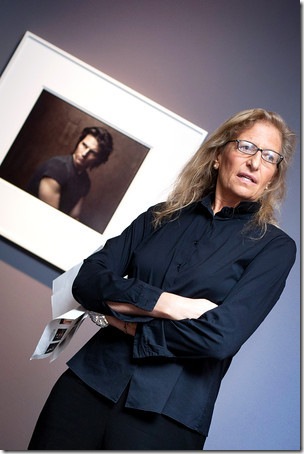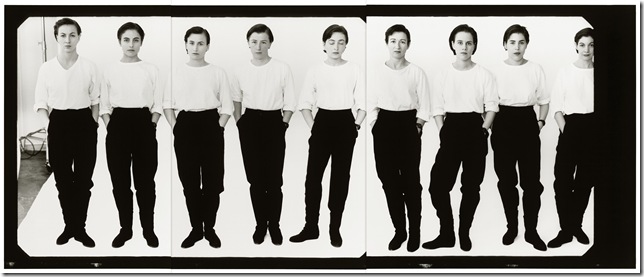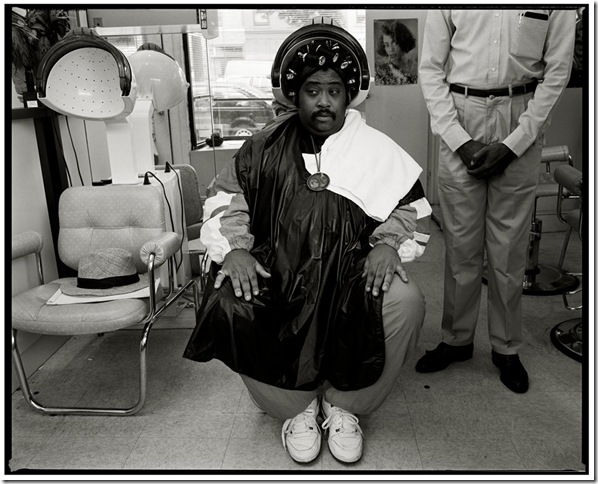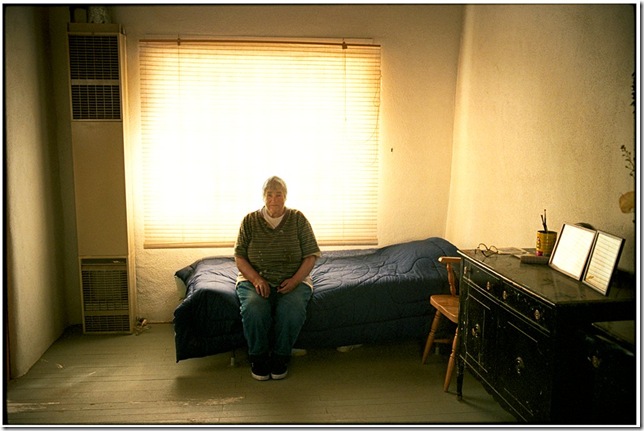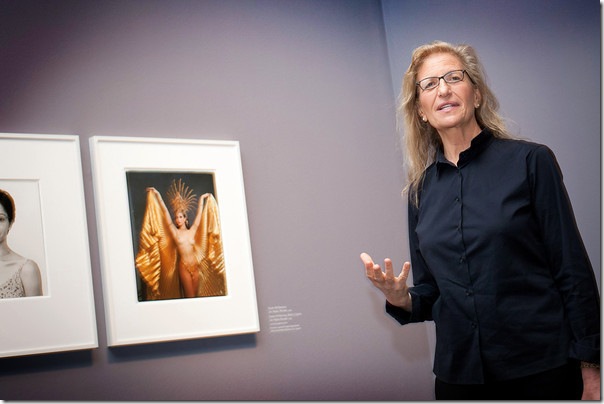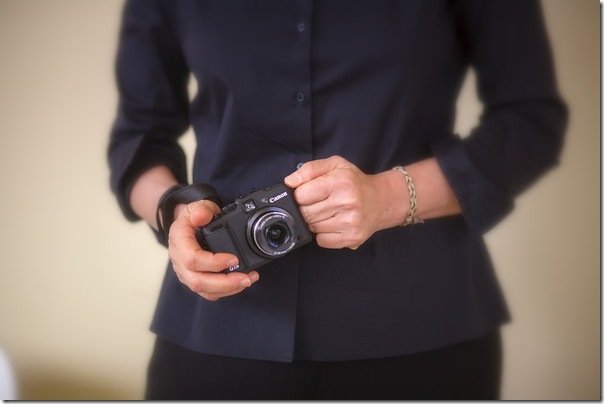By Tom Tracy
Leonardo DiCaprio is wearing a living swan around his neck, while Allen Ginsberg is caught tying his shoe in a grungy bathroom. And the Rev. Al Sharpton sits in a beauty salon with his hair up in curlers under a dryer.
Yet the laid-back Annie Leibovitz, one of American popular culture’s leading portrait photographers for four decades, said she has never pushed her subjects into the zany, usually memorable situations they are often presented in.
“I never make anyone do anything,” Leibovitz says, when asked what happens when her subject doesn’t especially want to do a particular idea.
To the contrary, Leibovitz thinks of herself as just an instrument helping draw forth her subject’s personality and their own conceptual ideas while she manages big picture concerns — getting the job done on schedule and in a location that works.
In fact, Leibovitz, who shot some 140 covers for Rolling Stone, said she sometimes wishes she were a more “edgy” photo artist.
“In the early days people like Rod Stewart were showing up and asking, ‘What do you want me to do?’ But I really prefer to let things unfold. I am a reluctant director. I prefer taking in real life and the things going on but I never make anybody do anything,” Leibovitz said during a stop in West Palm Beach recently to kick off a five-month exhibition here of some of her lesser-known works.
The Norton Museum of Art recently acquired 39 of her portraits. Exhibition curator Charles Stainback thought these pieces represented insightful examples of pure portraiture without all the celebrity hype associated with her signature shots of John Lennon, Whoopi Goldberg and Steve Martin.
Fresh off another installation project at the Wexner Center for the Arts in Columbus, Ohio, and a book project with speaking engagements at the end of last year, the 63-year-old Leibovitz apparently relaxed her usual tight grip during the Norton image selection process, making for an exhibit unlike her previous shows, according to Stainback, whose own expertise is in photography.
“I think she was intrigued that I wasn’t responding to famous pictures by a famous photographer, but that I responding to what I thought were significant portraits in her whole body of work,” he said. “It is really it is the first time she allowed a curator to go in there and make his or her own selections.”
“A lot of the pictures I really wanted and other ones she suggested and explained why it was really important,” Stainback said of the collaboration with Leibovitz.
The images are printed in relatively modest proportions and suggestive of the real dimensions that they would have appeared in the large magazines of their time. There are no wall-size prints here.
“It is really about traditional photography and that scale ― all too often now contemporary artists are making these gigantic four-by-six-foot prints but I think this is the size that we are used to looking at in a magazine,” he said.
The installation offers some familiar subjects alongs with some obscure faces: there is an early black-and-white print of serviceman taken during her family’s time on a U.S. military base in the Philippines ― where Leibovitz first started taking pictures. There is a fairly straightforward portrait of fellow-photographer Richard Avedon hung next to a companion still life Leibovitz took of Avedon’s large-format film camera.
In color film we encounter John Belushi wearing a winter coat, his hands in pocket and standing alongside a Staten Island road presumably in winter. We see musician and musicologist David Byrne dressed like a tree in what might have become an album cover but never did.
And we see an engaging portrait of Tom Cruise looking over his shoulder and in the direction of a related Leibovitz photo hung to the left and showing Vietnam war activist Ron Kovic, whom Cruise portrayed in Oliver Stone’s 1989 film Born on the Fourth of July. Kovic is seen passing along the Santa Monica beach in his wheelchair.
“I work with people who are at the top of their form or on their way to the top of their form. They are hard workers and they want a good photograph. We do a portrait in an hour or two: the challenge is, what can you do in that amount of time that is interesting and will tell the story?” Leibovitz thinks aloud, arriving at her secret formula: this artist gets out of the way of herself. “Life is stranger than my pictures.”
A Connecticut native, Leibovitz went west to study at the San Francisco Art Institute, where she hoped to become an art educator and to study painting. Instead she found her way to Rolling Stone, then a fledgling magazine where Leibovitz eventually became chief photographer. The decade there, she recounts in her 2008 book Annie Leibovitz: At Work, instilled in her a confidence that her work mattered and was important.
During the next 30 years, Leibovitz developed her style on the pages of Vanity Fair and in exhibitions at important galleries and museums worldwide. Yet she is humble in her own assessment: “It’s been my Achilles heel all my life: I would like to be a stronger, edgier photographer and I am not; I am a pushover. I like to like people; I want people to be happy … and it’s probably better that I photograph people that I like.”
Three subjects she said she would like to have photographed include dancer Martha Graham, Elvis Presley and Marilyn Monroe.
A retrospective of her work from the years 1970 to 1990 was presented by the National Portrait Gallery in Washington, D.C., and the International Center of Photography in New York. A Photographer’s Life: 1990-2005 opened at the Brooklyn Museum and toured widely, including to the National Portrait Gallery in London and the Hermitage Museum in St. Petersburg, Russia.
Last year, Leibovitz’s exhibition, Pilgrimage, opened at the Smithsonian American Art Museum in Washington, D.C. followed by a major exhibition last fall at the Wexner Center at Ohio State University.
Leibovitz was named a “Living Legend” by the Library of Congress in 2000 and received the 2012 Los Angeles Museum of Contemporary Art Award to Distinguished Women in the Arts. She lives in New York with her three children, Sarah, Susan, and Samuelle.
Annie Leibovitz runs through June 9 at the Norton Museum of Art, 1451 S. Olive Ave., West Palm Beach. Call 561-832-5196, or visit www.norton.org.
Video extra: For video clips with Leibovitz to accompany this story, see http://vimeo.com/user1919721.
